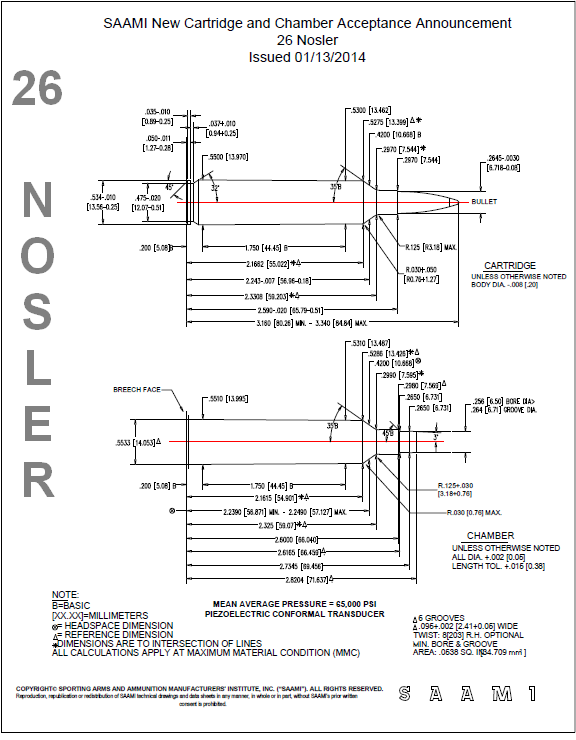April 25th, 2011
Selection from BARNES BULLETS’ Tips, Tools, and Techniques
by Ty Herring, Barnes Consumer Service
The purpose of this month’s Tip from Barnes is to make you aware of valid pressure signs in most centerfire rifle cartridges so you can keep yourself out of hot water. Following the Barnes Manual should do exactly that. Below are photos of cartridges that definitely had too much pressure. Fortunately [they] were fired in controlled circumstances and no one was injured. But this shows what can happen if you are not careful….

 High-Tech Pressure Testing Equipment
High-Tech Pressure Testing Equipment
At Barnes Bullets, we use some of the best equipment when we develop load data for you. Ours is state-of-the-art with a specialized “conformal” pressure system. This set-up uses a high-tech SAAMI-spec pressure barrel with a hole bored into the chamber area and a piezoelectric transducer is installed. As the pressure peaks under firing, the gauge that is specially calibrated reads the pressure and sends a signal to the control box where a technician can see the results.
For many years hand loaders have used the old fashioned trial and error method, hoping that by adding another grain of powder you don’t blow yourself up. Certain “guidelines” have been the standard — such as when the primer gets flat, or when the bolt locks up — you should stop and reduce the charge. These methods have worked for many, but some of them are more myth than reality. I’d like to go over some of these common pressure signs to help you avoid the pitfalls.
Pressure Signs That May Be Unreliable or Deceptive
When I first started hand loading centerfire rifle cartridges, I was told that when the primer flattens I should back the load down. This is one of those semi-myths. Some primers will flatten under high pressure and others will not. I’ve had some Remington primers that have blown right out of the case without ever showing any sign of flattening and on the other hand I’ve had Winchester primers that flatten with only a starting charge. I believe this to be a function of the thickness and hardness of the primer cup. The other myth that seems common is primer “cratering”. Cratering of the primer can be caused by a hot load. But it can also be a result of a slightly large firing pin hole in the bolt or a firing pin that is a bit too long or excessive headspace. Split or cracked cases are another area where it’s assumed that high pressure is the cause. Again this is only myth. Although it can be a result of high pressure — split or cracked cases are more likely caused due to a flaw in the case, improper head space or just simply from being sized and fired repetitively.

[Editor’s Note: Flattened Primers, Primer Cratering, and Cracked Cases CAN DEFINITELY BE CAUSED by excessive pressure. Accordingly, you SHOULD be careful when you see any of these conditions. If you see very flat primers or deep cratering be alerted that you may have exceeded safe pressures. Ty Herring simply makes the point that these telltale pressure signs may sometimes occur even when pressure levels are “normal” or moderate — due to the presence of other problems. Hence these indicators may be misleading. Nonetheless — all these signs (flattened primers, cratered primers, split cases) CAN be valid warnings. If you see these conditions, exercise caution because you may, in fact, have excessively hot loads.]
Valid Pressure Signs You Should Understand
So what are valid pressure signs? I’d say the most common and repeatable pressure sign that one can visually see is the “ejector groove mark”. It shows itself on the bottom of the case [between the edge of the rim and] the primer. It is caused when the pressures within the chamber force the case against the bolt face. On most bolt faces there is a round spring loaded ejector pin. On others there is a rectangular groove to eject the spent round. Under very high pressure the brass case will flow into this groove thereby causing the “ejector groove mark”. If and when you see this mark, it is a sure sign of high pressure. Some of the new high pressure cartridges such as the WSMs are made to run at these higher pressures and some factory loads will manifest the ejector groove mark even though they are within their pressure specification.

Older-Generation Cartridges
Some cartridges have very low maximum pressure ratings such as the 45-70, 30-30, 416 Rigby along with many others that will never show an ejector groove mark. Or should I say, they should never show one. By the time you reach that high of pressure in one of these rifles, it is likely the gun will be in pieces and the bolt may become part of you.
Sticky Bolt Lift and Difficult Extraction
Another common and very real high pressure sign is heavy or sticky bolt lift or extraction. This is caused due to the brass flowing and swelling in the chamber under tremendous pressure. However heavy bolt lift is not always a sign of high pressure. It may be caused by a variety of other issues. Knowing your gun and how it usually extracts a cartridge will be a clue as to whether or not you are actually getting high pressure.
This article appears courtesy Barnes Bullets. The article originally appear in the June 2011 Barnes Bullet-N Newsletter. Story tip from Edlongrange.
 Nosler has introduced a new 6.5mm (.264 caliber) hunting cartridge, the 26 Nosler. Nosler will initially offer 26 Nosler cartridge brass, and then, eventually, 26 Nosler loaded ammunition.
Nosler has introduced a new 6.5mm (.264 caliber) hunting cartridge, the 26 Nosler. Nosler will initially offer 26 Nosler cartridge brass, and then, eventually, 26 Nosler loaded ammunition.













 High-Tech Pressure Testing Equipment
High-Tech Pressure Testing Equipment






